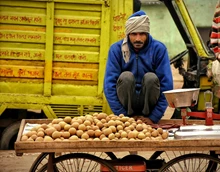
Pesticides spraying on the crops is common practice among the farmers. There are news that the chemical pesticides residues are in the fruits and vegetables. The same also destroys the soil and the water under the soil. To prevent the same CSIR scientists at Pune developed the compound. The compound may solve the problem and the produce shall be more safe now.
When pesticides are sprayed on crops, most of it generally bounces off the leaves, falling on the ground. It then mixes with soil and water, contaminating both, and entering the food and water cycle of human beings. This also results in a large amounts of wastage of pesticides.
Manoj Kumar, currently working at the National Centre for Biological Sciences, was a PhD student at the Council of Scientific & Industrial Research-National Chemical Laboratory in Pune, when he thought of this seemingly trivial issue as a scientific problem. Students completing their PhD from any of the CSIR laboratories are required to execute a project under the CSIR-800 programme, which encourages scientists to come up with science or technology solutions that can help improve the lives of the 800 million underserved people of the country. The CSIR-800 programme has three focus areas — value-added agriculture, waste-to-wealth, and energy efficiency.
As part of his CSIR-800 project, Dr. Kumar tried to explore whether it was possible to ensure that the pesticides sprayed on plants stuck to them, and did not fall off. He was not the first one to have given a thought to this problem, though. Farmers have been for decades using home-grown, rather ineffective, methods to solve this problem. One of the most common things that farmers do is to mix a little soap with the pesticide solution in water. Soap reduces the tendency of water to recoil from the plant surface but does not entirely eliminate it. Mixing of soap is, therefore, a half-solution, at best.

During this time, Kumar was working on structures formed by a lipid compound known as glyceryl monooleate (GMO) in a group led by Guruswamy Kumaraswamy. GMO, a wax-like solid, is a natural compound extracted generally from sunflower oil, and is used as a food emulsifier. It is thus edible, bio-compatible and food-grade. The interesting thing about the structure of this compound is that one end of it is hydrophilic (water-attracting) and the other end is hydrophobic (water-repelling).
Following discussions, Kumar and Kumaraswamy decided to test whether this interesting combination of hydrophobic and hydrophilic properties of GMO could make any difference. So they decided to use nanoparticles made from GMO in the pesticide solution instead of soap. The result was quite surprising. A large amount of the pesticide mix was now sticking to the leaves, and not falling off. Even at low concentrations of the GMO nanoparticles, the water stuck to the leaves, and more and more water stuck to the leaves as the concentration was increased.
The mechanism of how this was happening was not immediately evident, and Kumar and Kumaraswamy and their team spent months trying to figure out what exactly was going on. What they eventually found out was that, when the solution was sprayed, somehow the lipid GMO nanoparticles were rushing to the leaf surface and quickly spreading out to make a thin film, of the order of a few nanometres, on the leaves.
This film was hydrophilic on the outside. Thus, the water-pesticide mix that followed on to the leaves was no longer found to be repelling, and stuck strongly on to the new surface. The entire process of the GMO nanoparticles hitting the leaves and spreading themselves to form a thin coating happened in less than three milliseconds.
The scientists say the results can have far-reaching consequences, not just for pesticide use in the country, but also for different kinds of industrial coating applications. The fact that a vast majority of pesticides could be prevented from falling off to the ground and in water channels would ensure that there was a lesser risk of it entering the human food chain. Also, it would substantially reduce the quantity of pesticide sprayed on crops.
The researchers have carried out their studies in the laboratory. Now, they are collaborating with the industry to perform tests in open fields. The impact of GMOs on the potency of the pesticide, the right combination of GMO and pesticide in the mix, and the cost implications to the farmer are some of the things that are currently being tested.











